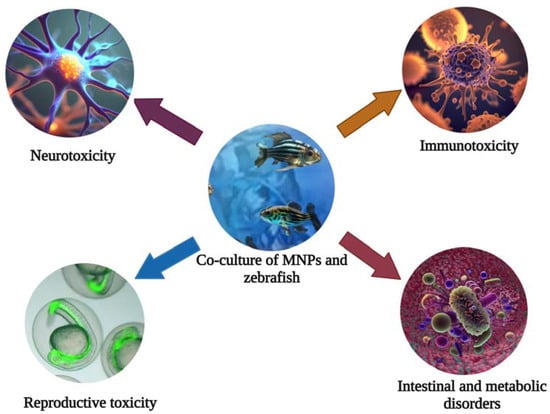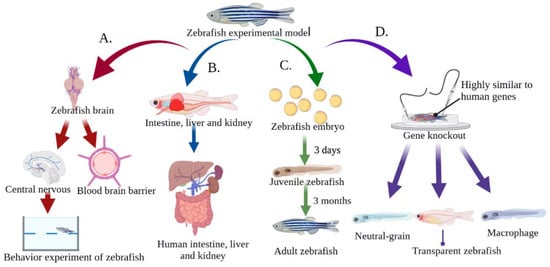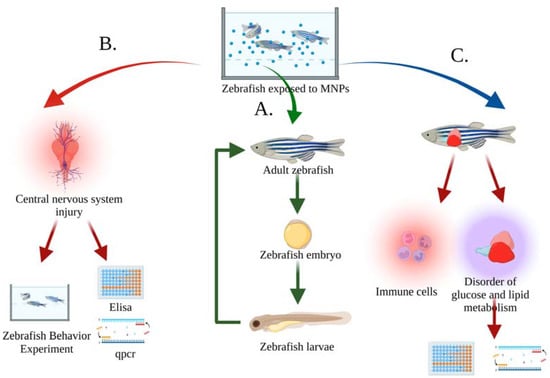You're using an outdated browser. Please upgrade to a modern browser for the best experience.
Please note this is a comparison between Version 1 by Da Sun and Version 2 by Camila Xu.
A large amount of nano-/microparticles (MNPs) are released into water, not only causing severe water pollution, but also negatively affecting organisms. Therefore, it is crucial to evaluate MNP toxicity and mechanisms in water. There is a significant degree of similarity between the genes, the central nervous system, the liver, the kidney, and the intestines of zebrafish and the human body.
- zebrafish
- nano-/microparticles
- toxicity evaluation
1. Introduction
Due to the continuous development of human activities, plastic products have become an integral part of our daily lives. However, with large quantities of plastic waste being discharged into water bodies, the global environment is expected to release 33 billion tons plastics of by 2050. In the course of environmental evolution, it will gradually decompose into tiny plastic particles called microplastics (MPs) (100–5000 nm) and nanoplastics (NPs) (<100 nm) [1][2][1,2]. Among the most common nano-/microparticles (MNPs) are polyethylene (PE), polypropylene (PP), polyvinyl chloride (PVC), polystyrene (PS), and polyethylene terephthalate (PET) [3]. Due to the small size, large surface area, strong adsorption capacity, and permeability of MNPs, their distribution and action mode in water are different from traditional organic pollutants [4][5][6][7][4,5,6,7]. High persistence and extreme distribution are unique characteristics of MNPs compared to other polluting suspended substances in the environment. As a result, MNPs are potentially harmful to freshwater and marine ecosystems [8][9][8,9]. Plastic debris has already caused an estimated EU 21 billion of severe economic damage in the world’s oceans. At the same time, due to their high surface area and hydrophobicity, MNPs can act as carriers of pathogens and organic pollutants, together with which they aggravate toxicity [10][11][12][13][10,11,12,13]. In addition, MNPs can enter the food chain circulation directly or indirectly, causing metabolic disorders and intestinal microbiota disorders in the human body. In addition, they cause neurotoxicity, reproductive toxicity, immunotoxicity, etc., which constitute serious threats to human health (Figure 1) [11][14][15][11,14,15].

Figure 1. The zebrafish can be used for toxicity evaluation and mechanistic studies of the nervous, reproductive, and immune systems of MNPs.
Therefore, to assess the toxicity of MNPs in water, many toxicity evaluation methods have been developed, including in vitro and in vivo methods. In vitro tests include chemical analysis and cytotoxicity tests [16][17][16,17]. These methods have limitations such as not reflecting real environmental conditions and complicated operation, and are time-consuming and laborious. A variety of animal models have been used to evaluate MNP toxicity in vivo, including mice, rats, rabbits, guinea pigs, and fish [18][19][20][21][18,19,20,21]. The zebrafish is a small freshwater fish. (I) Because of its small size, vitality, and reproductive ability, it is easy to raise and manage [22]; (II) its short life cycle, from fertilized egg to adult in about three months, allows for rapid large-scale experiments [23]; (III) Zebrafish larvae are transparent, and the development process of their internal structures and organs can be directly observed through a microscope. Therefore, they emerge in the field of toxicity evaluation of pollutants such as MNPs, heavy metals, pharmaceuticals, and algae in water [24].
2. Reliability of the Zebrafish for Toxicity Evaluation
Traditionally, mammals have been used to assess toxicity. Although the mammalian model has many advantages, it also has a number of disadvantages, such as its high cost, lengthy process time, and ethical and moral issues. Conversely, zebrafish are known for their fast population growth, short reproductive cycle, ease of experimental operation, high survival rate, and low feeding and maintenance costs [25][26][25,26]. Figure 2 illustrates the main advantages of using zebrafish in MNP research MNPs. These advantages include: (I) the genome of zebrafish has been completely sequenced, and the gene similarity to humans is as high as 87%. In addition, the pathological state of many diseases and genes related to disease etiology are highly conserved in humans [27][28][27,28]; (II) The transparent nature of zebrafish embryos and larvae provides an experimental advantage compared to other model organisms for studying the accumulation sites of fluorescence-labeled MNPs particles. In addition, transgenic zebrafish strains have become effective biological models for studying metabolic and immune diseases [29][30][29,30]; (III) The blood–brain barrier of zebrafish is similar to that of humans, and has been well used for central-nervous-system drug screening [31]; (IV) The nervous system of the zebrafish, which includes the central nervous system and the peripheral nervous system, has social behaviors similar to human perception, movement, and emotion. Zebrafish have become widely used models in behavioral neuroscience, especially as disease models for Parkinson’s disease (PD), Alzheimer’s disease (AD), and depression [32][33][34][32,33,34]; (V) Zebrafish have similar metabolic organs and physiological structures to humans, such as the liver, kidney, and intestine. These organs can metabolize and eliminate harmful substances as shown in Figure 2 [35][36][37][35,36,37].
Figure 2. Advantages of zebrafish for toxicity evaluation of MNPs. (A) The blood–brain barrier, central nervous system, and social behavior are similar to those of humans, making it an ideal animal model for studying neurotoxicity; (B) The intestine, liver and kidney are similar to those of humans, which makes them suitable for studying MNPs metabolism and immune diseases; (C) The reproductive and developmental toxicity of MNPs can be easily studied due to the short reproductive cycle of zebrafish and the large number of eggs laid. In addition, the embryos are transparent, so a microscope can be used to observe the cell division and organ formation process; (D) The genome of zebrafish has been fully sequenced, and is highly consistent with the human genome, and can be easily manipulated by genetic manipulation such as gene knockout and gene overexpression.
3. Toxicity of MNPs in Water to Zebrafish
Currently, the zebrafish used to evaluate MNP biotoxicity are manipulated by the exposure method [38][39][38,39], injecting MNPs directly into the aquaculture water or adding MNPs to the feed, and then exposing the zebrafish to the suspension for a specified period of time. Zebrafish behavior and physiological indicators can be observed during this period. As shown in Figure 3, acute toxicity of MNPs to zebrafish was evaluated by observing changes in growth, reproduction, behavior, and physiology. In addition, water-flow can also control MNP concentration and time to simulate dynamic MNP exposure environments.
Figure 3. Evaluation index of MNP toxicity in zebrafish in a water body. (A) Evaluation of the toxicity of MNPs on growth and reproduction by the damage and apoptosis of sperm, testis, and oocytes of adult zebrafish, as well as the increased rate of malformation and mortality of embryos [40][41][42][40,41,42]; (B) Evaluation of the behavioral and neurological toxicity of MNPs by increasing oxidative-stress level and apoptosis in the zebrafish brain, as well as behavioral experiments to detect memory, learning, and mental disorders in zebrafish [43][44][45][43,44,45]; (C) Evaluation of the toxicity of MNPs on the metabolism and immune system by the upregulation of immune-related gene expression and apoptosis, as well as the reduction of hepatic glucose and lipid metabolism, glucose, α-ketoglutarate, and lipid-related indicators [46][47][48][46,47,48].
